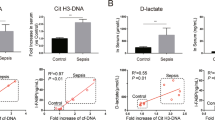Abstract
Nitric oxide (NO) appears to play a paradoxical role in intestinal physiology. Although NO has potent bactericidal effects, a growing body of evidence suggests that it mediates intestinal injury and breakdown of gut barrier function. Data from our lab and others show an increased incidence of bacterial translocation following endotoxin challenge, and upregulation of inducible NO synthase (iNOS) mRNA and protein in the intestine. These phenomena co-localize with enterocyte apoptosis at the tips of the intestinal villi and immunoreactivity to nitrotyrosine. Electron microscopy reveals swollen mitochondria, implicating these organelles as putative targets for NO or its reactive nitrogen intermediates. We review some of the literature and discuss our current work in trying to define this mechanism.
Similar content being viewed by others
Author information
Authors and Affiliations
Additional information
Accepted: 13 December 1999
Rights and permissions
About this article
Cite this article
Nadler, E., Ford, H. Regulation of bacterial translocation by nitric oxide. Pediatr Surg Int 16, 165–168 (2000). https://doi.org/10.1007/s003830050714
Issue Date:
DOI: https://doi.org/10.1007/s003830050714




